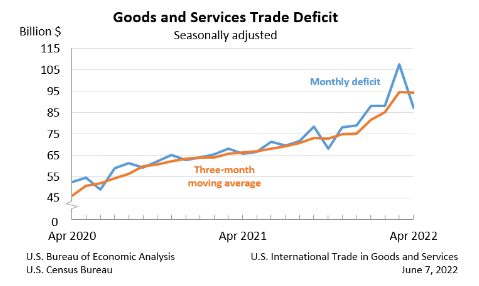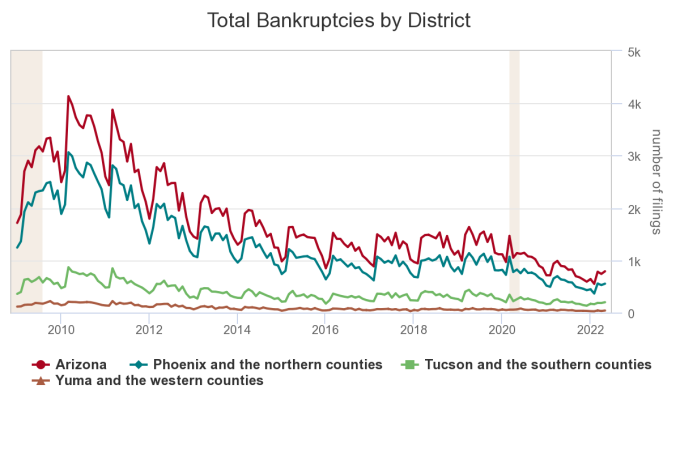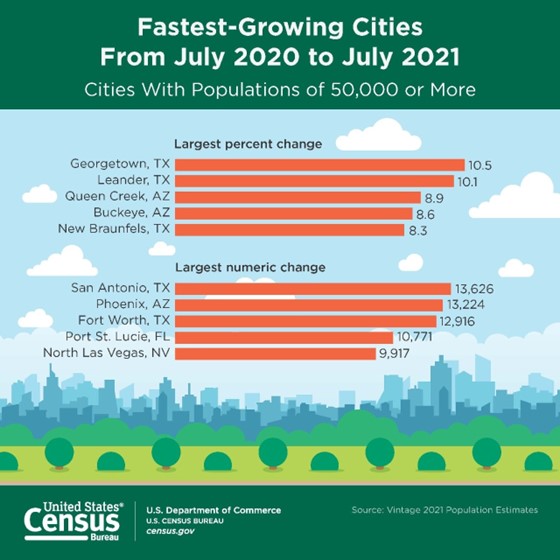Valorie Rice, Senior Business Information Specialist and
Shaw Zeider, Student Researcher
Current data releases as of 10 June 2022
Arizona had the second largest house price appreciation among all states between the first quarters of 2021 and 2022 at 27.5%, with only Florida having a higher figure at 29.8%. The Federal Housing Finance Agency (FHFA) House Price Index report for the first quarter 2022 indicated all 50 states and the District of Columbia had house prices increases over the year with the nation at an 18.7% increase. The Mountain division had the biggest upturn in prices over the year with 24.0%, which makes sense when you consider that out of the top 10 states ranked by price appreciation five were in mountain states: Arizona (2), Utah (3), Idaho (5), Montana (6), and Nevada (7). Metropolitan area data for all transactions (both purchase and refinance mortgages) indicate that Arizona metros had substantial house price increases over the year at 30.3% in Flagstaff, 30.1% in Phoenix, 27.1% in Yuma, 26.8% in Lake Havasu City-Kingman, 25.5% in Prescott Valley-Prescott, 25.2% in Tucson, and 23.6% in Sierra Vista-Douglas. The all transactions increase for Arizona and the U.S. were 28.7% and 19.4%, respectively.
Annual inflation rose to 8.6% in May, the highest it has been since 1981 based on the Consumer Price Index June 10 release from the U.S. Bureau of Labor Statistics. The 12-month change in consumer prices was headed by energy costs, which increased 34.6%, though food prices also contributed by rising over 10 percent for the first time in 41 years (at 10.1%). All items less food and energy increased 6.0% annually. The seasonally adjusted monthly index increased 1.0% in May after rising 0.3% in April. Shelter, gasoline, and food were the largest contributors to the monthly increase, though price escalations were broad-based. The index for all items less food and energy rose 0.6% over the month.
Use your cursor as a tooltip to switch series ON/OFF at the bottom of the chart. Run your cursor over the chart to view values.
For the first time in nearly 3 years, Phoenix is no longer leading the nation in home price growth. Looking at the year-over-year price increase in March, the title now goes to Tampa, Florida which recorded a 34.8% increase. Phoenix is still second in the nation with an increase of 32.4%. In March, the U.S. overall recorded an annual gain of 20.6% up from 20.0% in the previous month. The housing market does not seem to be slowing down based on these data, as the Phoenix March/February percent change was an increase of 3.0%. Nationally this figure was up 2.6% according to the S&P CoreLogic Case-Shiller Home Price Index May 31 release.
Yuma was the only place in the nation to have an unemployment rate higher than last April according to the latest metropolitan area employment report, moving up to 13.1% this April compared to 11.6% last year. El Centro, CA, on the other hand had the largest decrease over the year, falling 5.9 percentage points to 11.7%. The rate of 13.1% in Yuma was also the highest unemployment rate for the month out of all metropolitan areas, followed by El Centro – the only two areas with double-digit jobless rates. Two Minnesota metropolitan areas (Mankato-North Mankato and Rochester) shared the lowest unemployment rate for April at 1.3% each. April 2022 unemployment rates for the rest of Arizona metropolitan areas were: 4.0% in Flagstaff, 3.9% in Lake Havasu City-Kingman, 2.7% in Phoenix, 2.6% in Prescott, 3.4% in Sierra Vista-Douglas, and 3.1% in Tucson.
The U.S. trade deficit lowered in April, moving down $20.6 billion to $87.1 billion, after spiking to $107.7 in March (revised). The reduction of the deficit was due to an increase in exports and a decrease in imports. April exports of goods and services were the highest on record at $252.6 billion, an increase of $8.5 billion from March. Imports dropped $12.1 billion to $339.7 billion for the month. Year-to-date, the deficit was 41.1% higher than the same period a year ago based on the June 7 joint U.S. Census Bureau and U.S. Bureau of Economic Analysis release.
There were 789 bankruptcy filings in Arizona for May, 50 more than April and a decrease of 11.5% over May of last year. Chapter 13 (individual debt adjustment) had an over the year increase for the Phoenix office in May while the Tucson and Yuma offices had the same number as a year ago. All other forms of bankruptcy were lower over the year. Year-to-date, Arizona bankruptcies were down 17.5% in May, this included reductions of 18.2% in the Phoenix office, 12.4% in the Tucson office and 30.6% in the Yuma office. Only three counties in the state reported more bankruptcies year-to-date than last year, those were Navajo (Phoenix office), Graham and Santa Cruz (both Tucson office). The Phoenix office includes Apache, Coconino, Gila, Maricopa, Navajo, and Yavapai counties. The Tucson office oversees Cochise, Graham, Greenlee, Pima, Pinal, and Santa Cruz counties, while the Yuma office represents La Paz, Mohave, and Yuma counties.
U.S. nonfarm payroll employment increased by 390,000 in May on a seasonally adjusted basis. Leisure and hospitality followed by professional and business services were the sectors with the largest increases in employment for the month while retail trade employment declined. The unemployment rate was unchanged at 3.6% for the third month in a row according to the June 3 U.S. Bureau of Labor Statistics release.
Real Gross Domestic Product (GDP) decreased at an annual rate of 1.5% in the first quarter of 2022 on the second estimation. This is a further decrease from the original 1.4% estimated and a major decrease from an increase of 6.9% in Q4 of 2021. This can be attributed to decreases in private inventory investment, exports, federal government spending, and state and local government spending.
Data compiled by the U.S. Census Bureau looking at the period of July 1, 2020 to July 1, 2021 indicates Arizona is still growing quickly. The cities of Queen Creek, Buckeye, Casa Grande, Maricopa, and Goodyear represented Arizona among the 15 fastest-growing cities for 2021 population estimates. Queen Creek ranked 3rd with an 8.9% increase to bring the 2021 total population to 66,346. Buckeye ranked 4th growing 8.6%, Casa Grande was 7th at 6.2% and Maricopa came in at 8th place growing 6.1%. Lastly, Goodyear grew 5.4% to come in at 11th. Along with this, Phoenix was the second-largest numerical gainer behind only San Antonio, with a numeric increase of 13,224 and was the fifth largest city in the nation for 2021.








